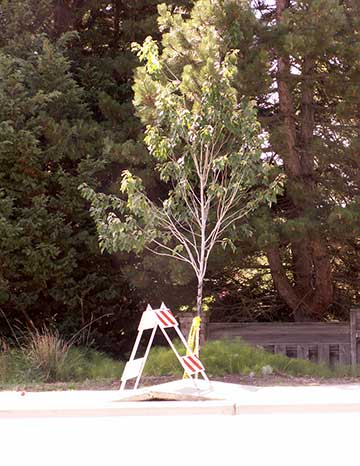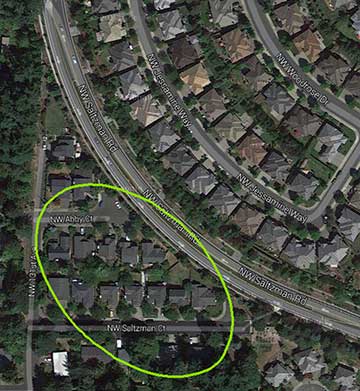 |
Previous Issues |
| Cedar Mill Community Website |
|
Search the Cedar Mill News: |
About The Cedar Mill News |
|
|||||||
| Volume 11, Issue 12 | December 2013 |
||||||
Whose sidewalks?
|
||||||
 |
| The buckled sidewalk in last June's heat wave |
The months went by, and the buckled sidewalk remained (it’s still there!). Some investigation revealed the problem. State law requires that repair of sidewalks in unincorporated areas is the responsibility of the adjacent landowner. ORS 368.910¹ states, “the owner of the abutting real property shall maintain and repair the sidewalks or curbs.”
This works fine in cases where the sidewalk is directly adjacent to and accessible by that landowner. But increasingly the fashion for roads like Saltzman, 143rd, and Bethany Boulevard—collectors by the county’s road classifications—is to separate the sidewalk from the adjacent fences with planting strips and not allow access to the residential areas except via a few entrances. Developers are building self-contained subdivisions where there is very limited access to collector/arterial roads (as mandated by the various jurisdictions, in this case Washington County). On those collectors and arterials, the county requires a sidewalk, but the adjacent property owner is separated from it. They have no more or less interest in the sidewalk than anyone else in the subdivision.
So the homeowner in this case would have to walk several blocks to access that sidewalk. Their back fence abuts the road. Understandably, they balked when presented with a notice from the county. On further study, Schamp said, “I agree that the property owner shouldn't be saddled with fixing a newly constructed sidewalk and I have been working with ECS (Matt Costigan) to have the repairs made on the MSTIP nickel. I'm pretty sure that's happening, but if not, we will get it taken care of without charging the property owner.”
 |
| The broken sidewalk is in an area where no houses front on Saltzman. |
Because it is a state law, any change in the situation will only come about with a change in that law. Our State Representative Mitch Greenlick has agreed that there is a problem, and has agreed to work on it for the 2015 session (legislation seldom goes quickly).
Greg Malinowski, our County Commissioner, responded, “The biggest issue with changing this law is who pays the tens of millions of dollars in right-of-way upkeep costs from all over the state?”
Greenlick expressed a similar concern. “Help me understand why this should be a responsibility of taxpayers at large, rather than the responsibility of the property owner, who it seems will profit by improving their property. I do understand the special issue of Bethany Blvd.”
Although it’s not my job to write law, I have given this some thought too. In the case of new developments, either the county should include a fee for 40-or-so years of sidewalk maintenance in the Transportation Development Tax fees initially charged for the development, or make it the responsibility of the Home Owners Association if there is one. Many new subdivisions create HOAs from the beginning. The developers of the new proposed Arbor development on Saltzman stated they would include Saltzman sidewalk maintenance in the HOA assessment for their new homeowners.
For existing sidewalks where the above situation exists, if there is a HOA, they should cover the cost. If there is no HOA, perhaps a Local Improvement District should be formed that would assess people within some radius of the sidewalk, as a group, for the maintenance.
This should deal with the problem going forward, and relieve those individual homeowners of the onerous responsibility to pay for something they can't access to any degree more than their neighbors (in many cases, less than many of their neighbors). Most of the subdivisions and homes that were built years ago are not separated from the sidewalks, so assessing the adjacent homeowner makes a lot more sense.
Stephen Roberts, Communications Coordinator for Land Use and Transportation at the County, responds, “Per statute, the abutting property owner is ultimately responsible for the sidewalk. As noted, we are pursuing other avenues to get this repair done. You’ve offered some good suggestions to consider moving forward, but all have logistical challenges associated with them… but that doesn’t mean they shouldn’t be given some consideration.”
In the meantime, pedestrians still have to navigate the buckled sidewalk by walking in the mud or the street. We do hope the county figures it out sometime soon and repairs it, whoever ends up paying.
![]()
Like us on Facebook for timely updates
Published monthly by Pioneer Marketing & Design
Publisher/Editor:Virginia Bruce
info@cedarmillnews.com
PO Box 91061
Portland, Oregon 97291
© 2013